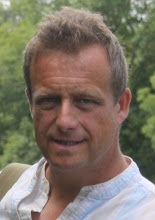A cold bright day, the valley scoured by a stiff wind, the sky bright and clear in strong sunlight; the shadows of the clouds moving softly across a bare hillside, a small herd of horses racing across a field.
Coming home from Presteigne I saw again the alignment of the valley, almost definite east-west. The well/spring at Byton that could be a Bronze Age religious site would, I realised, sit on the hillside facing the setting sun. Yet there was a second possibility. On the hillside high above the valley is a spring, clearly marked even today; another water-source and almost on the same grid reference. They were worth an afternoon's walking so I walked along the old toll road (bare branches knocking together like walking sticks) and across the fields to find the well. And if what I found is the site, it is bigger and more obvious than I had expected. In a low bank is a horseshoe of level ground around a series of pools which could be springs, or all feeding from the one spring. It is surrounded by shrubs and low trees and faces exactly the setting sun. The sheep use it to drink from, but what would survive after two millennia? When history is absent it is preferable to explore landscape creatively, poetically, or through symbol. The pool is protected by the shrubs and low trees, descendants perhaps of the vastly ancient grove it was once hidden by; and one larger sycamore (a Roman tree) stands guard to the right.
In this mood I carried on up the hill behind the site and joined an old forestry track in the woods. This in turn led onto an older track alongside the woods and up onto the achingly bare hill behind them. The older track - deep, overgrown ruts, a slice away of the hillside - disappeared under fallen trees, but a newer walking trail led up onto the bare field. The second possibly-Bronze Age water source was a deep brown pool in the steep hillside, guarded by holly trees and oaks. There seemed something ancient about the idea of holly and oak, but here too there was nothing to indicate a religious site apart from the size - the pool was about ten feet across - and the location, which was facing south-west across a huge piece of Herefordshire; on this clear afternoon I could see about 40 miles. I could see two bonfires in the valley far below, the smoke trailing in the fierce wind. On the way down the hill I found an ancient hollow-way, overgrown and used as an unofficial tip; but the thought occurred to me that the old woodside path on the way up could have led to the pool, and this hollow-way (still guarded by old old trees) could have led down. Did I find Bronze Age sites? I do not know. I saw trees that look like stone, bleached branches like old bones, hard ground the colour of ivory; I found a sheep's skull near the hill pool and above the treeline; I walked through deep deep tyre ruts the colour of sand and found an old hollow-way, still a green place in the surrounding harsh blond fields, and I think I found the water-source that has been described as a possible Bronze Age site. An astonishing walk and in the end it does not matter; the eyes, the way, to see the landscape are more important than what is seen.

No comments:
Post a Comment